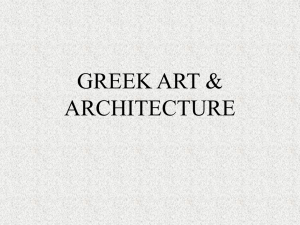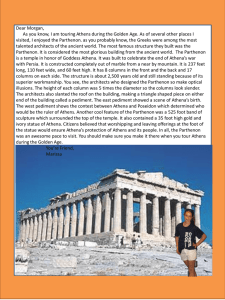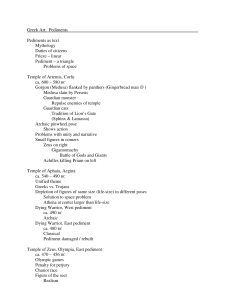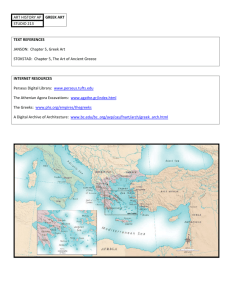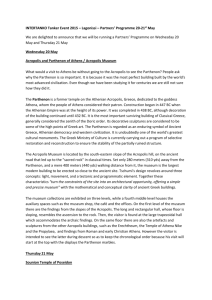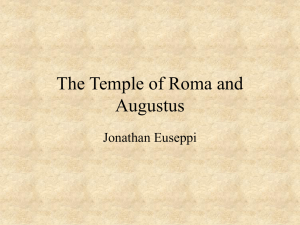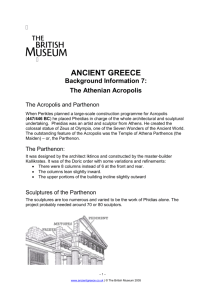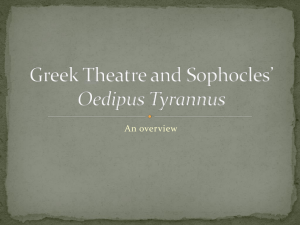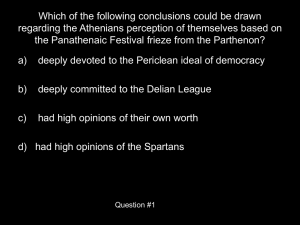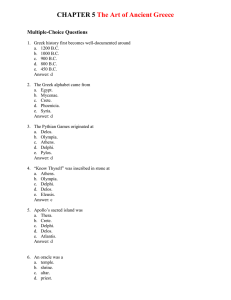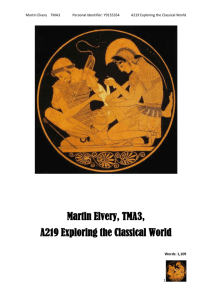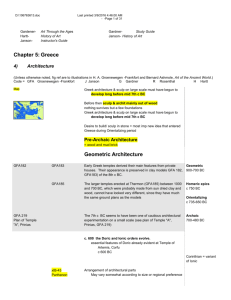File
advertisement
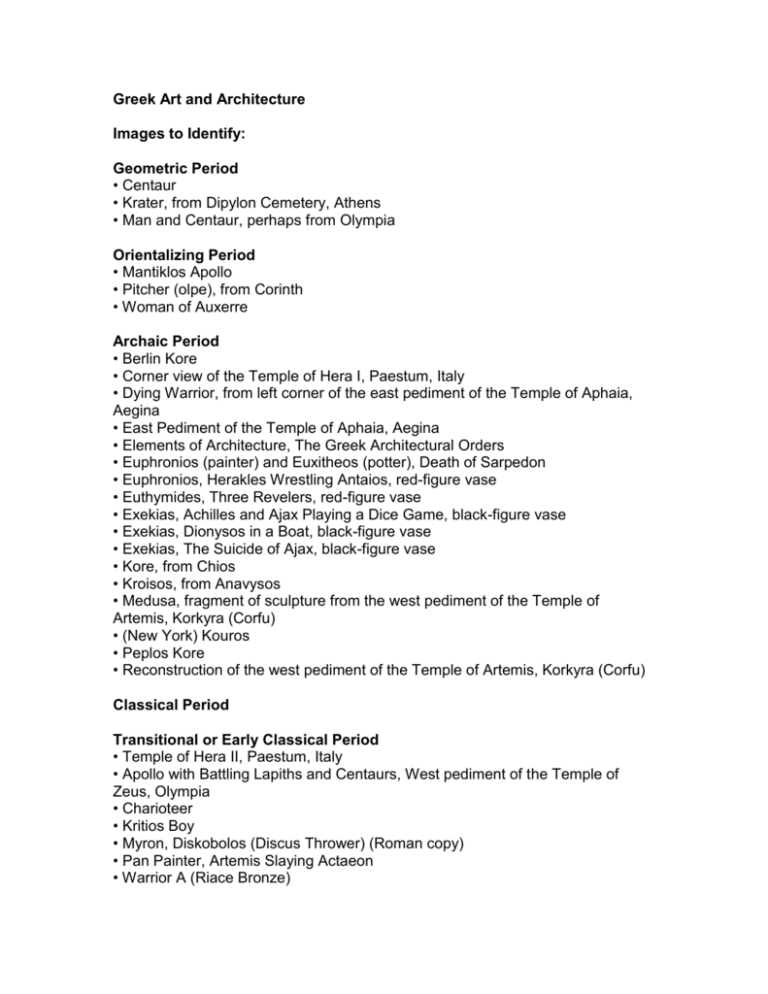
Greek Art and Architecture Images to Identify: Geometric Period • Centaur • Krater, from Dipylon Cemetery, Athens • Man and Centaur, perhaps from Olympia Orientalizing Period • Mantiklos Apollo • Pitcher (olpe), from Corinth • Woman of Auxerre Archaic Period • Berlin Kore • Corner view of the Temple of Hera I, Paestum, Italy • Dying Warrior, from left corner of the east pediment of the Temple of Aphaia, Aegina • East Pediment of the Temple of Aphaia, Aegina • Elements of Architecture, The Greek Architectural Orders • Euphronios (painter) and Euxitheos (potter), Death of Sarpedon • Euphronios, Herakles Wrestling Antaios, red-figure vase • Euthymides, Three Revelers, red-figure vase • Exekias, Achilles and Ajax Playing a Dice Game, black-figure vase • Exekias, Dionysos in a Boat, black-figure vase • Exekias, The Suicide of Ajax, black-figure vase • Kore, from Chios • Kroisos, from Anavysos • Medusa, fragment of sculpture from the west pediment of the Temple of Artemis, Korkyra (Corfu) • (New York) Kouros • Peplos Kore • Reconstruction of the west pediment of the Temple of Artemis, Korkyra (Corfu) Classical Period Transitional or Early Classical Period • Temple of Hera II, Paestum, Italy • Apollo with Battling Lapiths and Centaurs, West pediment of the Temple of Zeus, Olympia • Charioteer • Kritios Boy • Myron, Diskobolos (Discus Thrower) (Roman copy) • Pan Painter, Artemis Slaying Actaeon • Warrior A (Riace Bronze) High Classical Period • East Pediment of the Parthenon • Erechtheion, Acropolis, Athens • Horsemen, detail of the Panathenaic Procession, from the Ionic frieze on the north side of the Parthenon • Kallikrates and Iktinos, Parthenon, Acropolis, Athens • Kallikrates, Temple of Athena Nike, Acropolis, Athens • Lapith Fighting a Centaur, metope relief, from the Doric frieze on the south side of the Parthenon • Marshals and Young Women, detail of the Panathenaic Procession, from the Ionic frieze on the east side of the Parthenon • Model of the Acropolis, Athens • Nike (Victory) Adjusting Her Sandal, fragment of relief decoration from the parapet (now destroyed), Temple of Athena Nike, Acropolis, Athens • Phidias, Athena Parthenos, model of lost statue • Photographic mock-up of the east pediment of the Parthenon • Polykleitos, Spear Bearer (Doryphoros) (Roman copy) • Porch of the Maidens, (Caryatid Porch), Erechtheion, Acropolis, Athens • Three Goddesses, from the east pediment, Parthenon Late Classical Period • Lysippos (?), Alexander the Great • Lysippos, Apoxyomenos (Scraper) (Roman copy) • Praxiteles, Aphrodite of Knidos (Roman copy) • (Followers of) Praxiteles, Hermes and the Infant Dionysos (Roman copy) Hellenistic Period • Alexandros of Antioch-on-the-Meander, Aphrodite of Melos (Venus de Milo) • Athanadoros, Hagesandros, and Polydoros of Rhodes, Laocoön and His Sons • Athena Attacking the Giants, detail of the frieze from the east front of the Altar from Pergamon • Epigonos(?), Dying Gallic Trumpeter • Nike (Victory) of Samothrace • Reconstructed west front of the Altar from Pergamon, Turkey Vocabulary: abacus acanthus leaf acropolis Archaic smile architrave base black-figure painting The Canon capital caryatid cella (naos) centaur column contrapposto (counterbalance) Doric order, Ionic order, Corinthian order drum echinus entablature entasis frieze kore (korai, pl.) kouros (kouroi, pl.) kylix metope naturalism Panathenaic Procession pediment Peloponnesian War peplos peristyle Persian War pronaos red-figure painting shaft stereobate strigil stylobate triglyph volute Who was who in ancient Greece: Alexander the Great Antigonus (Antigonid Dynasty) Aphrodite Athanadoros Athena Attalos I Dionysos Exekias Hagesandros Herakles Hermes Iktinos Kallikrates Lysippos Medusa Mnesikles Perikles (also spelled Pericles) Pheidias (also spelled Phidias) Polydoros Polykleitos Praxiteles Ptolemy (Ptolemaic Dynasty) Seleucus (Seleucid Dynasty) Skopas Be able to list/distinguish the five Greek periods: Geometric, Orientalizing (which is not discussed in your book), Archaic, Classical, and Hellenistic. Be able to label/identify the components of the Greek Doric and Ionic orders as illustrated on page 100, Elementst of Architecture.
